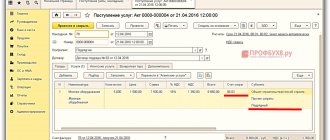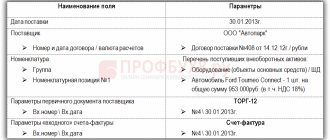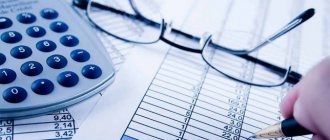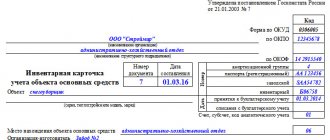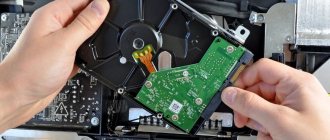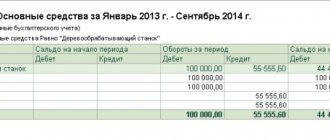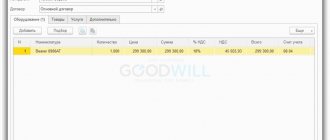Accounting procedure
First, let's look at the basic processes when buying a car.
The car is accounted for as a fixed asset. After purchasing a car, a state duty is paid to the traffic police either before putting the car into operation or after. This determines where the state duty will be included:
- in the cost of the car to account for fixed assets, if the duty is paid before putting it into operation;
- to the organization's expenses if the duty is paid after commissioning.
Depreciation is then calculated monthly for the vehicle.
For car ownership, transport tax is calculated annually and a declaration is generated.
Next, consider an example: an organization buys a Renault Logan car for 500,000 rubles, with a power of 97 horsepower. The state duty is included in the cost of the car.
Situation. The driving school purchased a training vehicle
A driving school organization purchased a passenger car for use in practical classes on learning how to drive a power-driven vehicle in the training of category “C” drivers.
The car must be registered with the traffic police, and duplicate pedals must be installed, which requires a business trip to another city.
1. How should accounting take into account the costs of fuel used when registering a car with the traffic police and during a business trip (for installing backup pedals)?
2. Are all of the following costs included in the initial cost:
– purchase price of the car;
– costs associated with registering a car with the traffic police and obtaining a technical passport;
– driver’s travel expenses for installation of duplicate pedals;
– cost of installing duplicate pedals;
– technical inspection (TO) of the car and state duty for issuing a permit to participate in road traffic;
– 15-day compulsory car insurance?
The increase in the value of a fixed asset includes:
– purchase price of the car;
– costs associated with registering a car with the traffic police;
– cost of installing duplicate pedals.
The increase in the value of a fixed asset also includes expenses such as:
– fuel within the established consumption standards;
– driver’s travel expenses for installing backup pedals within the established standards.
Operating costs include:
– passing state maintenance;
– compulsory car insurance.
Let's look at the rationale behind the above answer |*|.
* Information on the distribution of tax deductions, incl. arising during the acquisition of fixed assets, between turnovers subject to VAT
Determining the initial cost of the purchased car
The organization accepts for accounting as fixed assets assets that have a tangible form, while simultaneously meeting the following recognition conditions:
– assets are intended for use in the activities of the organization, incl. in the production of products, when performing work, providing services, for the management needs of the organization, as well as for provision for temporary use (temporary possession and use), except for cases established by law;
– the organization expects to receive economic benefits from the use of assets;
– assets are intended to be used for a period of more than 12 months;
– the organization does not intend to alienate assets within 12 months from the date of acquisition;
– the initial cost of assets can be reliably determined (part one of paragraph 4 of the Instructions for accounting of fixed assets, approved by Resolution of the Ministry of Finance of the Republic of Belarus dated April 30, 2012 No. 26; hereinafter referred to as Instruction No. 26).
The initial cost of acquired fixed assets is determined in the amount of actual costs for their acquisition, including:
• cost of acquisition of fixed assets;
• cost of customs duties and duties;
• cost of interest on loans and borrowings;
• cost of insurance upon delivery;
• the cost of expenses for the services of other persons associated with bringing fixed assets to a condition suitable for use;
• the cost of other costs directly related to the acquisition, delivery, installation, installation of fixed assets and bringing them into a condition suitable for use (part one of paragraph 10 of Instruction No. 26).
Actual costs associated with the acquisition of fixed assets, delivery, installation, installation and bringing them into a condition suitable for use are reflected in the debit of account 08 “Investments in long-term assets” and the credit of accounts 10 “Materials”, 60 “Settlements with suppliers and contractors” ", 69 "Calculations for social insurance and security", 70 "Settlements with personnel for wages", 76 "Settlements with various debtors and creditors" and other accounts.
The generated initial cost of fixed assets is reflected in the debit of account 01 “Fixed assets” and the credit of account 08 (clause 11 of Instruction No. 26) |*|.
* Information on determining the initial cost of a fixed asset and its selection in the accounting policy for 2021.
In some cases, the initial cost of fixed assets may change, incl. in case of reconstruction (modernization, restoration) of fixed assets, carrying out other similar work (clause 14 of Instruction No. 26). Installing duplicate pedals on a training vehicle is an upgrade.
Actual costs associated with modernizing a car are reflected in the debit of account 08 and the credit of accounts 10, 60, 69, 70, 76 and other accounts. The amounts of these costs recorded on account 08 are debited from this account to account 01 upon completion of the work (clause 20 of Instruction No. 26).
Regarding the driver's travel expenses for the installation of duplicate pedals, please consider the following. In cases where travel expenses are directly related to the acquisition of fixed assets (installation of duplicate pedals), the initial cost of such objects will be formed taking into account travel expenses. It is important to clearly state the purpose of the business trip in the business trip order.
A similar approach can be applied to accounting for fuel consumed for a business trip.
Thus, if the driver is sent on a business trip and its purpose is to modernize a fixed asset, then travel expenses and consumed fuel are included in the initial cost of the fixed asset.
The following entries will take place in accounting (see Table 1):
Accounting for the costs of maintaining and operating a car
Actual costs for maintaining fixed assets in working condition (technical inspection and maintenance, carrying out all types of repairs) are recognized as expenses in the reporting period in which they were incurred (clause 20 of Instruction No. 26) |*|.
* Information explaining that not in all cases of increase in the value of fixed assets an investment deduction can be applied
The following entries will take place in accounting (see Table 2):
__________________________ * Instructions for accounting of income and expenses, approved by Resolution of the Ministry of Finance of the Republic of Belarus dated September 30, 2011 No. 102 (hereinafter referred to as Instruction No. 102).
** Instructions on the procedure for applying the standard chart of accounts, approved by Resolution of the Ministry of Finance of the Republic of Belarus dated June 29, 2011 No. 50 (hereinafter referred to as Instruction No. 50).
*** Tax Code of the Republic of Belarus (Special Part) dated December 29, 2009 No. 71-Z (hereinafter referred to as the Tax Code).
Order of the Ministry of Transport of the Republic of Belarus dated June 21, 2011 No. 304-C approved methodological recommendations for planning, accounting and calculating the cost of work and services in road transport organizations of the Republic of Belarus.
In order to determine the composition of current costs for the maintenance, servicing and operation of vehicles, these recommendations can be used, incl. organizations that do not have departmental subordination.
Setting up transport tax
Let's define the settings for transport tax: the procedure for paying taxes and the method of reflection in accounting.
To do this, open the settings for taxes and reports in the menu “Main - Settings - Taxes and reports”. Next, find the item “Transport tax” and follow the link “Procedure for paying taxes locally.”
Here we indicate the validity date and tax payment deadline.
Next, follow the link “Methods of reflecting expenses.”
We will indicate the action date, expense account, department and expense item.
Settings can be set for the entire 1C database, or divided by organization or vehicle.
Accounting for car leasing
When accruing leasing payments due to the lessor for the reporting period, an entry is reflected in the credit of account 76 “Settlements with various debtors and creditors”, subaccount “Debt on leasing payments” in correspondence with the accounts of production (circulation) costs.
If, under the terms of the leasing agreement, the leased property is taken into account on the balance sheet of the lessee , then the accrual of lease payments due to the lessor is reflected by an internal entry in the debit of account 76 “Settlements with various debtors and creditors”, the subaccount “Lease obligations” and the credit of account 76 “Settlements with various debtors and creditors ", subaccount "Debt on leasing payments".
Business transactions for accounting for car leasing are as follows:
| Business transactions | Dt | CT | Amount, rub. |
| Transfer of advance payment in accordance with the terms of the leasing agreement | 60.02 | 51 | 696200 |
| The initial cost of the car under the leasing agreement was formed on the basis of the supporting document | 08.04 | 76.05 | 1488000 |
| Reflects the commissioning of a fixed asset object | 01.01 | 08.04 | 1488000 |
| Lease payment according to schedule | 76.05 | 60.01 | 74500 |
| VAT on leasing payment | 19.3 | 60.01 | 13410 |
| Advance paid according to schedule | 60.01 | 60.02 | 31860 |
| To be transferred for this month according to the schedule | 60.01 | 51 | 56050 |
| Depreciation of leased property | 26 | 02 | 40216,22 |
| Formation of deferred tax liability | 68.04 | 77 | 6856,76 |
| VAT deduction on lease payment for this month | 68.02 | 19.3 | 13410 |
In accounting, the initial cost of the leased asset is repaid through depreciation. In this case, the use of a multiplying factor not higher than 3 is provided only with the reducing balance method. That is, with the linear method, the use of an accelerated depreciation mechanism is not allowed .
Buying a car
To reflect the purchase of a car, we will create a document “Receipts (acts, invoices)”, type of operation “Equipment”.
On the “Equipment” tab we will indicate the Renault Logan car and its cost of 500,000 rubles.
We will also register an invoice.
Let's look at the document postings.
The cost of the car is collected on the account on 08.04.1.
State duty for car registration
We will pay the state registration fee and include it in the cost of the car.
To make payment, create a document “Write-off from current account”, operation “Payment of tax”.
In the document we indicate:
- Organization and date of payment.
- Tax paid:
- Accounting account 68.10.
- Tax amount.
Let's look at the document postings:
To include the state duty in the cost of the car, use the document “Receipt of additional. expenses." The easiest way is to create it based on the document “Receipt (invoice acts)”.
In the document:
- In the “Settlements” section we set the settlement account to 68.10.
- On the “Main” tab, indicate the amount of additional expenses.
- The “Products” tab will be filled in automatically.
Document postings:
In postings, the subconto for account 68.10 is not filled in automatically. To change, check the “Manual adjustment (allows editing of document movements)” checkbox and indicate the subconto.
As a result, the cost of the fixed asset increased by the amount of state duty.
When should a vehicle be put into service?
Question from Clerk.Ru reader Zhanna (Veliky Novgorod)
We purchased a car from an individual. The PTS indicates the date of purchase and sale as 01/14/10. Date of registration is 01/22/10. All state fees were paid on January 19, 2010. On what date should we put the vehicle on account 01 in the BU and NU? And will state fees be included in the initial cost?
The question of the moment of putting an object into operation of fixed assets, in the case under consideration - a car, is not regulated by regulations. This is decided by the management of the organization, depending on whether the object is ready for use in production activities.
When putting vehicles into operation, the following must be taken into account. According to paragraph 3 of Art. 16 of the Federal Law of December 10, 1995 N 196-FZ “On Road Traffic Safety”, vehicles are allowed for road traffic on the territory of the Russian Federation by registering them in accordance with the legislation of the Russian Federation.
